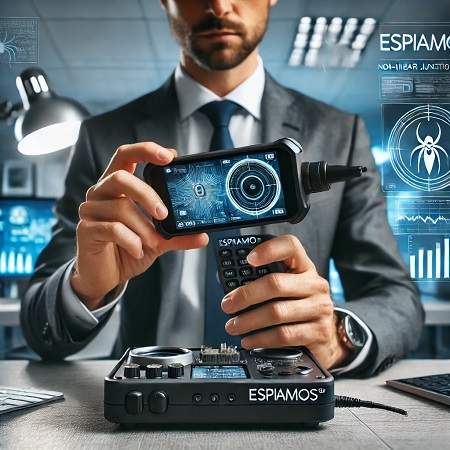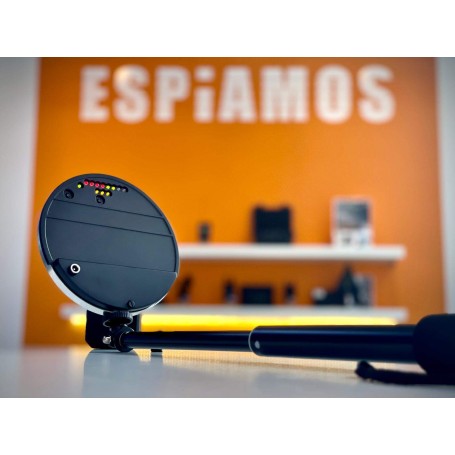Non-linear detectors ( NLJDs ) are specialized security devices used to detect the presence of hidden electronic components, such as spy cameras, microphones, and GPS trackers. Their ability to locate electronic devices, even when they are turned off or unplugged, has made NLJDs essential tools in the fight against espionage and privacy protection.

Table of contents
- What is a non-linear motion detector (NLJD)?
- Working principle of nonlinear detectors
- How is a NLJD different from a radio frequency detector?
- Real-life application examples
- Conclusions
What is a non-linear motion detector (NLJD)?
A non-linear bug detector (NLJD) is a device designed to locate electronic components in their environment, such as semiconductor chips. Unlike traditional RF detectors, which can only find devices that emit a signal, NLJDs have the ability to detect hidden electronic devices even if they are turned off or not actively transmitting . This is crucial in situations where spy devices may be designed to not emit detectable signals for long periods of time.
These non-linear detectors are common tools among security professionals such as government agencies, law enforcement, and businesses looking to protect sensitive information. Their ability to detect a wide range of electronic devices makes them a versatile and reliable option in today's security.
Working principle of nonlinear detectors
The operation of a non-linear detector is based on the emission of a low-power radio frequency (RF) signal. When this signal comes into contact with a semiconductor device, such as an electronic chip, a non-linear response is produced that the NLJD can detect. In simpler terms, when the radio frequency signal interacts with a semiconductor, it generates a distortion in the signal, which is picked up by the detector.
NLJDs are able to identify the presence of these semiconductors regardless of whether the device is on or off. This makes them ideal for detecting devices that might be hidden in a room, vehicle or even in everyday objects such as watches or pens.
The detector uses an antenna that emits the signal and then analyzes the response. Based on the strength of the nonlinear response, the NLJD can accurately locate the hidden device and its position. Most modern nonlinear detectors are equipped with visual and audio interfaces that make them easy to use, allowing users to interpret the results quickly and efficiently.
This operating principle makes NLJDs highly effective tools for security, offering accurate and reliable detection, even in environments where electronic devices are designed not to be discovered.

How is a NLJD different from a radio frequency detector?
Although non-linear detectors (NLJD) and radio frequency (RF) detectors have a common goal—locating hidden electronic devices—the way they operate is fundamentally different. A RF detector is designed to detect active electromagnetic signals, such as those emitted by spy microphones or cameras when they are in operation. These detectors can only locate devices that emit an active signal, meaning that if a device is turned off or in passive mode, it is virtually undetectable to them.
Non-linear detectors, on the other hand, can locate semiconductor devices whether they are on or off. This is one of the main reasons why NLJDs are a superior choice in scenarios where a more thorough inspection is required, such as vehicle inspections, offices, or rooms where the presence of spy devices is suspected. Even if the device has been designed not to emit active signals (such as a GPS tracker in passive mode), an NLJD can detect its presence thanks to the non-linear response of the semiconductor.
Additionally, RF detectors can be affected by environmental “noise,” such as Wi-Fi signals or transmissions from legitimate devices. NLJDs, on the other hand, are not affected by this interference because they do not rely on active signal transmission. This makes them a more reliable option for accurate detection of hidden devices in complex environments.
While an RF detector can be useful for identifying devices that are active and transmitting, NLJDs offer much more comprehensive coverage. This key difference explains why NLJDs are considered an advanced and preferred tool in situations where security and privacy are paramount.
Real-life application examples
Nonlinear detectors have multiple applications in the modern world, where privacy and security are of vital importance. Below are some common examples of their use:
Protection against corporate espionage
In companies, NLJDs are used to ensure the confidentiality of meetings and the security of premises. Spy devices, such as hidden microphones or cameras, are a real threat to many companies that handle sensitive information. An NLJD can sweep a conference room, for example, to detect the presence of hidden devices, ensuring that crucial information is not leaked. Even if a device is switched off or in passive mode, the NLJD can identify it.
Personal safety
On a personal level, NLJDs are useful for detecting hidden GPS trackers in vehicles or listening devices in the home. Individuals who feel threatened by spying or unauthorized tracking can use these devices to conduct routine inspections and protect their privacy. A non-linear detector can identify potential threats without the need for the devices to be in operation, offering an additional layer of protection.
Applications in police investigations
NLJDs are also key tools in police investigations. They allow law enforcement officers to locate electronic evidence that might be hidden during a criminal investigation. From cell phones to hidden cameras, detectives can use these devices to find electronic devices that might have been deliberately turned off or disconnected to avoid detection. This is especially useful in scenarios where criminals are trying to hide electronic traces.
The versatility of NLJDs, combined with their ability to detect devices in all types of conditions, makes them indispensable in various areas of security, from corporate environments to private life and legal investigations.
Conclusions
Non-linear detectors (NLJD) are essential tools in modern security. Their ability to detect hidden electronic devices, even when they are turned off or not emitting active signals, makes them a valuable resource for both businesses and individuals who wish to protect their privacy. Unlike traditional RF detectors, NLJDs offer a more complete solution by identifying semiconductors and other electronic components without relying on signal emission.
Whether in a corporate environment, a personal inspection or a police investigation, NLJDs can detect a wide range of spy devices, such as hidden cameras, microphones and GPS trackers. Their accuracy and reliability make them indispensable in scenarios where privacy and security are crucial.
In short, the advanced technology employed by non-linear detectors makes them a superior detection tool, capable of adapting to different situations and needs. As electronic threats continue to evolve, having a device like an NLJD can make all the difference in protecting sensitive information and personal safety.
What should we consider when choosing an NLJD?
When choosing the best non-linear detector for your needs, there are several factors to consider. While more advanced models may offer a greater detection range or additional features, this does not always mean they are the best choice for all users. Below are some key points to consider:
- Detection Range: NLJDs vary in their ability to detect devices at different distances. Some high-end models, such as the Cayman ST-403 , have a longer range, making them ideal for large areas. However, if you only need to inspect smaller spaces, a model like the NLJD 3HECA-01 might suffice.
- Portability: If mobility is important, it is advisable to opt for a compact and easy-to-carry NLJD. Models such as theEDD-24T or Sword 24S offer excellent portability without compromising performance.
- Ease of use: The interface of the device is critical, especially if you have no prior experience using non-linear detectors. Models such as the NLJD 3HECA-01 stand out for their ease of use, making them accessible to a wide variety of users.
Which nonlinear detector is best for you?
While there are high-end non-linear detectors that offer a longer range and more advanced features, sometimes the price is not justified by the extra features. In this regard, the NLJD 3HECA-01 stands out as the best option due to its excellent value for money. This model combines advanced features, such as detection of inactive devices, with an affordable price, making it a reliable and efficient alternative.
While devices like the Cayman ST-403 may be suitable for professional users who need a longer range, most users will find that the NLJD 3HECA-01 offers all the necessary features without the high investment required. Its ease of use, coupled with its ability to detect a wide range of devices, makes it the best choice for those looking to protect their privacy without compromising their budget.
All in all, the NLJD 3HECA-01 is the nonlinear detector we recommend for most users due to its combination of affordable price, reliable performance, and ease of use.






 WhatsApp
WhatsApp Telegram
Telegram


